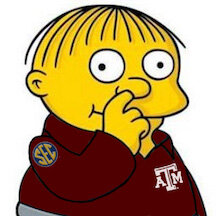Football ...
Basketball ...
Baseball ...
Other Sports ...
Futbol ...
🤫995🤫 ...
Gambling ...
Movies & TV ...
Music ...
Hobbies ...
Lulz ...
Food & Travel
...
Daily Texan ...
Business & Markets ...
Cloak Room ...
Help ...
For Sale ...
Board Discussion ...
Advertise...
Tailgate Donations
-
Posts
3098 -
Joined
-
Last visited
-
Days Won
1
Content Type
Profiles
Forums
Store
Downloads
Recruiting - 2020
2019-2020 Football Season
Football
Entertainment
Sports
News and Business
Cloak Room
Transfer Portal
Recruiting
Events
Everything posted by Randolph Duke
-
Rick Perry is not only an aggy, he is a consummate aggy. He openly admits his intellectual struggles are what lead him to politics. Thanks for your service, Rick.
-
No CR. Just typical Rick Perry. He has never been one to stop and think. It's a typical aggy trait. Once Rick couldn't remember the three agencies he was committed to eliminating while running for president, people pretty much ignored aggy Rick.
-
You can easily tell it is the aggy Rick Perry. The problem with proper spelling (even with spell check) is classic aggy.
-
aggypedia is down for TWO DAYS and we already are getting this type of cluelessness over who aggy really is. We know this doesn't describe Texas A&M for many reasons. First of all, A&M isn't the biggest university in the U.S. While in Texas, A&M trails such academic powerhouse institutions as Lone Star College and Dallas Community College System in enrollment, nationally A&M trails such powerhouse universities as University of Central Florida and, A&M's true peer institution, the University of Phoenix. "Quantity over quality" certainly is an academic standard. Not an admirable one, but it is the one aggys hold near and dear to their hearts. And yes, aggy is laughing all the way to the bank these days. Especially aggy athletics. Laughing all the way to the bank to sign the loan papers because they (yet again) are in a multi-year cycle where aggy athletics can't pay its bills from operating income. Searching high and wide to find the "aggy trifecta" of repressive government, overt racism, and oppression of women; aggy partnered with the government of Qatar to create a "branch institution" to burnish A&M's reputation. Only at A&M can someone who hasn't been closer than 12,000 miles to the College Station campus can "students" be granted degrees that read "Texas A&M, College Station, Texas." Most universities have a degree requirement that each student step foot on the campus at least once prior to graduation. Not Texas A&M. I do have to give the aggys one bit of credit. Through Qatar's strong relationship with the Taliban, it will be just a matter of time before the "aggy engineering" that A&M is now collaboratively exporting to Afghanistan will lead to a crisis of collapsing wooden structures in Afghanistan, killing untold numbers of non-whites. Pretty sneaky, aggys. The ags need to place a large sign above the entrance to their engineering building that reads "What starts here leads to death around the world." But hey, "don't matter, got Jimbo!" The people of Texas deserve better than Texas A&M. Hell, for that matter the people of Afghanistan deserve better than Texas A&M.
-
No, I didn't. Skimming very quickly for highlights is just one of many many skills. Bullet points and headlines that say things like "Main Findings" are sometimes subtle clues. It's a consultant report written for aggys. One big "SWOT" report written by kids three years out of grad school. I didn't look at the page count, but if it is 133 pages, about 128 are sheer waste. The problem with A&M is simple - It's run by aggys. aggys are largely simple minded people who struggle to envision what change might look like and who never see enough of the world outside their insular culture to understand just how backwater their culture truly is. The answer - a complete restructuring and a total de-Nazification of the aggy system and TAMU senior administrators. Replace them with people who understand the value of higher education and who don't care about the idolatry, fairy tales, and fake army shit that define A&M today.
-
We avoided the shitshow because Urban turned us down, not because someone pulled their head out of their ass and decided to pass on Urban. The idiot UT Regent and boosters thankfully lacked the ability to force Urban to accede to their demands. I'm not sure how you missed that.
-
Awesome. How could anyone not have wanted this guy as head coach at UT. And remember, there were people insisting he not only needed to be hired but put solely and completely in charge of all aspects of UT football, reporting not to the AD but directly to the university president.
-
The notion of an all-male, military component of the school impinges upon the culture of higher education.
-
As we prepare for "doesn't matter, got Jimbo" from aggys in response to any constructive comment about TAMU, the university recently commissioned an outside review of the university. Among the findings of the report: (my personal favorite - "Faculty losing sight of need to continue educating, advancing knowledge, and granting degrees." As I have often said, A&M exists to promote white trash, redneck culture, not to promote knowledge.) •Limited financial resources to recruit and retain talented faculty and staff. Not competitive enough with the marketplace. •The campus faces a deferred maintenance challenge regarding its infrastructure. •The Aggie culture impinges upon the potential for change within the university. The notion of an all-male, military component of the school impinges upon the culture of higher education. •Lack of investment in and inclusion of other TAMU branches and locations. •The current organizational structure within the university is unclear, including what the deans are responsible for and to whom they report. This includes siloing and lack of lateral communication. Individuals often re-invent the wheel instead of collaborating. •The current strategic approach is not specific enough to TAMU and could apply to any university. •Faculty review process is not thorough and the push to innovate is lacking. •Student Affairs is unorganized, does not oversee all of the correct functions, and could be improved with restructure. •Inconsistency in processes, problem-solving, tasking, and organization has created an ad hoc conglomeration of “one-offs” that make it difficult for individuals to identify their responsibilities. •Marketing and Communication’s strategy is decentralized and unclear. Crisis messaging is outdated. University communication is generally disjointed, unclear, inefficient, and a struggle. Faculty learns of significant organizational changes through the wrong channels, e.g., social media. •Lack of faculty diversity and poor retention of diverse faculty members both at the university and department levels. •University climate not always welcoming, particularly to diverse faculty, staff, and students. Enrollment of diverse students, particularly African Americans, is low. Student and faculty populations do not reflect the state population. •Perception that TAMU history and culture have negatively impacted student body diversity. TAMU has historically been conservative and slow to change regarding diversity issues. Fish Camp is an example of this—there is a lack of control over the content of the camp. The challenges of polarized politics have the potential to threaten core values. •No clear ownership of the current strategic plan. •Faculty losing sight of need to continue educating, advancing knowledge, and granting degrees. •Continuation of inefficient processes, process loopholes, and resource allocation. •Lack of transparency and consistent communication from university leadership. Many faculty and staff members are anxious about changes in leadership, which has happened often in recent years. There is a fear that lack of transparency and communication to and amongst faculty members could create a culture of cynicism and lack of respect. https://cache.cloud.tamu.edu/feedback/TAMU_Comprehensive_Review_10192021.pdf?_ga=2.71616339.1708821177.1635166615-58743126.1634661426&_gl=1*9a7efm*_ga*NTg3NDMxMjYuMTYzNDY2MTQyNg..*_ga_SJ5GMN0ZQL*MTYzNTE4NzE4NS41LjEuMTYzNTE4ODEwMC42MA..
-
If you are tOSU and you need to do a mea culpa, to you fall down before Urban, or Luke Fickell?
-
No. The risk of immense brand damage is just too high. Urban is toxic.
-
No way in Hell. If Urban ever comes back he’s going to have to do like Freeze, Briles, Petino. He’s going to have spend a few years back at Bowling Green, or some place similar to wash some stink off himself.
-
And this is why I ignore people who give me shit about what I post. People who supported the idea of Urban Meyer as head football coach at UT Austin need to ask themselves what they missed about Urban and how they intend to avoid the same fucking mistake next time.
-
If we were serious about winning championships in college football we wouldn’t be outsourcing oversight and control of the program to Regents and donors who have proven themselves not to be up to the challenge.
-
You would make a lousy Cubs fan. Or Knicks fan. Or Cleveland Browns fan. Or....
-
College sports is first and foremost a live entertainment product. In live sports entertainment, there have always been very popular products that failed to deliver consistently in the competitive sphere. It is what it is. If you want to talk about the lack of accomplishment given the resources, talk to those on the academic side. They see far more instances of gifted individuals failing to live up to their potential. And far more instances of the unexpected individuals who develop during their college careers. The money rolls in because of increasing demand for the product. It happens when you have the only major live sports entertainment product in a rapidly growing market whose demographics are strongly shifted to the demographics the product is focused on. Kids between the ages of 18 and 24 do inexplicable things. Welcome to life. Meanwhile, Cincinnati is in the CFP with recruiting classes over the past four years that don't even average to being in the top 50. Crazy, ain't it?
-
Let's not kid ourselves, Barry just shut his mouth and let what Jimmy built do what it did. One could never accuse Barry of being an intelligent man, but he wasn't stupid.
-
You forgot to include Barry Switzer as a coach who made it to the top in both college and pro football. With coaches having such defined personality and character traits, it is interesting that there has been so little written about which attributes are positives and which are negatives, as well as which ones translate from one level to another. Obviously, Urban didn't have what it took to succeed in the NFL, but neither did Saban or Spurrier. That Urban's potential for failure at the pro was so badly missed is interesting. If I were a betting man, I would wager the lessons inherent in Urban's failure will be completely ignored.
-
Take a moment to stop and look at yourself in a mirror this morning and realize you are part of the problem, not part of the solution. It is possible to succeed in life without leaving enormous, steaming piles of shit in your wake and damaging the lives of those you meet along the way. Try it some time.
-
And to think I would have voted for you to replace CDC as AD in a few years.
-
Treating College Athletes as Employees May Create New Problems https://view.email.sportico.com/?qs=7eac272631d80d4ba8a08af256df67d030eeb6a1cc9a919e1a331d430d14d5b4e9845399e56ab6a0cf50de78e9c083f1443a89867934b204b57779ae93c458ede0b61af96ca310dff0584e90fb38d109 In the last few weeks, five coaches have signed contracts worth nearly $500 million , strengthening the argument for those who believe college athletes deserve to be paid. As we wrote yesterday, that could become a reality in 2022 if college athletes are reclassified as employees. But Casey Schwab (CEO and founding partner, Altius Sports Partners)—and a pair of Power 5 athletic directors, who all view reform very differently from those advocating on behalf of the athletes—caution that athletes are likely to find out the grass is not greener on the other side. “This whole idea that the continued expansion of athletes’ rights [to include a minimum wage and the ability to collectively bargain] is necessarily better for the athletes is likely a fallacy,” Schwab said. JWS’ Take: To be clear, no one we spoke to was against players being compensated. As one AD who asked to remain anonymous said: “When you have Brian Kelly going to LSU for $15 million, that creates a very [distinct] contradiction. You begin to think… is that fair, should the LSU players be getting some of that [money]? I say they should be, and we should figure out how they could.” But both ADs and Schwab were in agreement that reclassifying college athletes as employees is not the answer. Schwab explains that those pushing for change in employment status—which would guarantee college athletes a minimum wage and enable them to collectively bargain for a percentage of revenues—are leaving out some key details. “If you’re an employee, you join a union and sit down to bargain, everything from wages, to health care, contract length, security clauses and other fundamental aspects of the athlete-school relationship—from scholarships, to visa status, financial aid, insurance, workers’ comp, terminations would be on the table for negotiation. So all of the benefits that college athletes currently enjoy could potentially be taken away.” And any benefits that remain—including the value of their education—could be taxed. It is worth noting that revenue sharing only applies if there is revenue to share (50% of $0 is $0). “If you’re in the MAC, and you’re spending $10 million net-negative a year to fund the football program, why are you going to pay more [in salaries] to lose more? Versus just going [to a lower level] and saying we’re not even going to have scholarships anymore, we’re just going to have need-based aid. If students want to come and have this [college sports] experience, they can come and pay to have this experience. It would be devastating for opportunities,” the unnamed AD said. It is worth noting that of the 1,000 or so schools that comprise the NCAA, about 800 of them currently use athletics to fill beds. Heeke agreed that “if the model changes, it will dramatically impact [schools’] ability to support the opportunities that exist for thousands of young people.” Like the other AD, he does not believe universities will agree to underwrite additional losses for a football program already operating in the red and said there would probably “be a whole resetting of all other sports into more of a club program. There would be much more limited space [for Division I programs] with revenues going into the player labor force.” It’s also safe to assume if the players are being paid, college football rosters will also be closer in size to those in the NFL (as opposed to the 125 players many currently carry). There are some D-I programs operating at a loss that would survive should this seismic shift occur. “It just depends on the school and the cash flow. Harvard and Princeton have broad-based sports programs that their alums fund. A university with an elite golf or tennis program might choose to keep playing golf [at that level],” the anonymous AD said. College athletes being deemed employees will likely open the door to the seemingly inevitable breakaway of football’s biggest powers. “About 50 schools will spin off their football programs into licensed entities,” the AD said. “They will hire coaches and hire players and as part of [those players’] employment at [XYZ] Inc., maybe they have the opportunity to go to the [affiliated] school. Is that really going to be best [for an 18- to 22-year-old]?” Heeke agreed a “break-off of the Division I football playing body” would likely occur. But he wasn’t convinced it would be 50 schools (or that the athletes would be students). “There could still be further dissection among the [Power 5],” he said. While some football programs would balk at paying athletes, there are others (think: SEC football powers) that would likely welcome their athletes becoming employees. Remember, employees face repercussions when they don’t meet minimum performance standards (i.e. they can be terminated), and they will sign binding contracts, which would limit their ability to transfer out of the program.
-
Conference championship?! aggy has struggled to finish above .500 in conference play for most of the past quarter century. They have struggled to just be competitive against conference competition.
-
There is not a single individual on the planet who has seen Texas A&M compete for or win a national championship in any major sport.
-
Employment Rights Expected to Shake Up College Sports Landscape in 2022 https://view.email.sportico.com/?qs=6b7ecb3dc4f1abae6d819dfc0a9864bf90f72984480a79e4108ff12b5022de7620c608e0cbcb5b15adfb73631d4cdf1600682e3b61b5e28361cc7c0077401eafc8aa2bd5865e5a36731e97eaeeec239a Name, image and likeness has garnered most of the headlines related to NCAA reform over the last year. That is despite the bulk of NIL deals thus far being relatively insignificant social media or appearance-based tie-ups (at least in terms of dollars spent). The NIL ecosystem will undoubtedly mature as national brands and major agencies enter the space. Group licensing will also raise the stakes. But Casey Schwab (CEO and founding partner, Altius Sports Partners) says there is a greater shift on the horizon that college administrators ought to be focusing on, one that will “completely change the college sports landscape and the economics of it,” he said. “The next wave for conference commissioners, college presidents and athletic directors to grapple with is going to be employment rights.” And he says that wave could wash ashore as soon as 2022. JWS’ Take: By definition, college athletes are not employees. They are classified as amateurs and sign a social compact (not a binding contract) with their respective universities. There are several ways that dynamic could change. College athletes could gain employee status via legislation (either at the federal or state level), litigation or the National Labor Relations Board (NLRB), which could deem a group of athletes at a private institution employees (the NLRB only governs private schools and the rights afforded would be dependent on state and local laws). Schwab said all three of those avenues are actively being pursued, and he expects “one, two or all three of those dominoes will fall in 2022.” Conversations with a pair of Power 5 athletic directors indicated the NLRB domino might be the most imminent threat to the current collegiate model. Back in September, NLRB general counsel Jennifer Abruzzo issued a memo stating that in her view college athletes have statutory rights in line with what employees receive under the National Labor Relations Act. One AD who asked to remain anonymous said he would not be surprised if a group of college athletes were granted employment status within the next 12 months (an unlikely scenario given the process involved). If that were to happen, it “would be a game changer,” Dave Heeke (director of athletics, University of Arizona) said. Players would gain a multitude of rights and protections under employment law that the schools would have to honor if they wanted to continue playing at the Division I level (think: minimum wages, vacation time, workers’ compensation and FMLA). But Schwab says most notably, it would give college athletes the ability to form unions and collectively bargain with their universities. And once the negotiations begin, “You’re going to see a collective bargaining agreement that includes revenue-sharing demands in revenue-positive sports, which may eventually change the economic framework of college athletics,” he predicted. To be sure, the people interviewed for this column see reform differently from athlete advocates, and are wary of shocks to the current system. A potential middle ground does exist, which Schwab says Congress could create. Under that scenario, Schwab says, college athletes would be “pseudo employees or employees for limited purposes, which would entitle them to healthcare and other benefits, but they wouldn’t necessarily get paid salaries.” Both of the ADs we spoke to believe a modified collegiate model (which would allow athletes to retain existing benefits and protections, including a tax-free education, and include some additional benefits or opportunities) is the ideal outcome. The problem for the NCAA, the conferences and its schools is that the decision will be made for them—and that the timeline is out of their control (of course, they could have addressed these issues long ago). Schwab says college administrators should be “starting to prepare for the change in employment status because it is more imminent than people think. The clearest path to athletes not becoming employees is Congress stepping in and siding with the NCAA, which is less likely than people think.” While both of the ADs we spoke to said college sports administrators are well aware of the possibility there could be a change in athletes’ employment status, they said few have taken concrete action to prepare for it. Heeke explained that with so many challenges converging on college sports at once (see: NIL, redefinition of the NCAA, conference realignment, CFP expansion, etc.) and so much uncertainty, it is hard to be proactive. “It is certainly a topic of conversation when we’re all together in group settings, whether that is at the conference or national level,” Heeke said. “And there is significant concern this could go down that road. But there are not formulated plans to implement at this point.”
Football ... Basketball ... Baseball ... Other Sports ... Futbol ... 🤫995🤫 ... Gambling ... Movies & TV ... Music ... Hobbies ... Lulz ... Food & Travel ... Daily Texan ... Business and Markets ... Cloak Room ... Help ... For Sale ... Board Discussion ... Subscribe!... Donate!... Advertise... COOKIE MONSTER!





